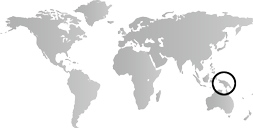In the opening years of the twentieth century, European powers complete their colonization of Melanesia as France and England agree to joint sovereignty and government of Vanuatu in 1906. In the same year, Britain transfers control of its holdings in New Guinea to Australia. Following World War I, Australia assumes control of Germany’s holdings in New Guinea and its adjacent islands as well. Apart from these developments, the political status of Melanesia’s archipelagos remains essentially unchanged until after World War II. The first three decades of the twentieth century mark the most intensive period of scientific exploration and collection in Melanesia. Numerous scientific expeditions and hundreds of individual anthropologists, adventurers, and explorers penetrate all but the remotest corners of the region, documenting its indigenous arts and cultures and making vast collections of objects, which are sent to museums and universities in Europe, Australia, and the United States. During the 1920s and ’30s, the growing body of Melanesian art in the West becomes an important influence on the Surrealists, whose haunting otherworldly imagery is, in some cases, directly influenced by Melanesian sculpture.
During World War II, many parts of Melanesia become important locations in the Pacific Theater. Japanese forces occupy New Guinea, the Solomon Islands, New Britain, New Ireland, Manus, and other islands, while the Allies establish military installations in New Caledonia and Vanuatu. A number of major battles take place on Melanesian islands, including Guadalcanal and Bougainville in the Solomon Islands, as well as in New Britain and New Guinea. As all of the prewar colonial territories in Melanesia were governed by Allied nations, after the war they are returned to their previous colonial administrations. Substantial movement toward political independence does not begin in earnest until the 1960s. In 1975, the eastern half of New Guinea, together with New Britain, New Ireland, Manus, and the North Solomon Islands, collectively achieve independence as the nation of Papua New Guinea. The majority of the Solomon archipelago becomes the independent nation of the Solomon Islands in 1978, followed by Vanuatu in 1980. By the close of the century, only Western New Guinea, now a province of Indonesia, and New Caledonia, which remains a French possession, are under non-Melanesian governments.
The massive cultural disruptions that occur among indigenous groups throughout Melanesia during the twentieth century frequently have devastating effects on the region’s artistic traditions. In many places, art forms such as wood sculpture dramatically decline or cease altogether as colonial authorities outlaw intergroup warfare, previously an important focus of art and religion for numerous Melanesian peoples. As the century progresses, more and more Melanesians convert to Christianity, neglecting, discarding, and, at times, actively destroying art forms associated with earlier indigenous religions. In some instances, however, local art forms such as songs, dances, and masking traditions become incorporated into Christian ritual and continue to be practiced. The ongoing presence of outsiders, either as residents or temporary visitors, also results in the emergence of an extensive variety of objects produced for sale as curiosities. Most of these are based on earlier sculptural traditions, but some, such as the openwork “storyboards” of the Kambot people of New Guinea, which depict scenes from local oral traditions, represent new forms developed expressly for the foreign market.
During the last quarter of the twentieth century, the broader renaissance of indigenous art and culture taking place in other regions of the Pacific, such as Polynesia and Australia, occurs in Melanesia as well. Traditional visual and performing arts that were previously declining or neglected are rejuvenated and rediscovered by new generations of Melanesian artists. Across the region, a series of contemporary art movements also begins to emerge, pioneered by artists such as Mathias Kauage (1944–2003) of Papua New Guinea. In 1998, the Tjibaou Cultural Center, the first major institution built primarily to showcase works by contemporary indigenous artists from throughout the Pacific, opens in Nouméa, New Caledonia.
In Western nations, the decades after World War II witness an increasing recognition and celebration of the remarkable achievements of Melanesian artists. As wider appreciation for what is then referred to as “primitive” art develops among both audiences and critics, works from Melanesia are incorporated as part of broader surveys of “primitive” or Oceanic art. However, almost immediately, exhibitions devoted exclusively to Melanesia, such as Human Forms in the Art of Melanesia (1952) in Auckland, New Zealand, or Mélanésie (1954) in Brussels, also begin to take place. These are soon followed by exhibitions devoted to individual or regional artistic traditions. Initially, these more specialized presentations focus almost exclusively on the artistic traditions of New Guinea and include Kunstwerke vom Sepik (1954) in Basel, Switzerland, The Art of Lake Sentani (1959) and Art Styles of the Papuan Gulf (1961) at the Museum of Primitive Art in New York, and numerous others. In the 1990s, the first major survey exhibitions of art from New Caledonia (1990) and Vanuatu (1996) take place. Unlike virtually all their predecessors, the two exhibitions are presented in their countries of origin as well as European venues.


